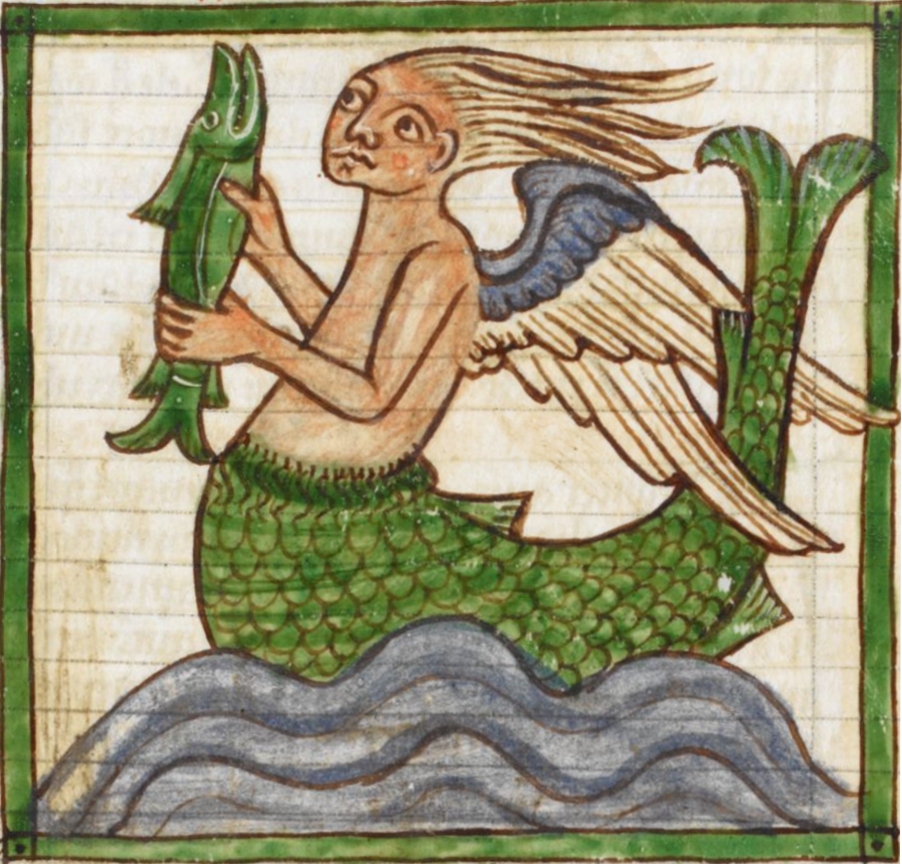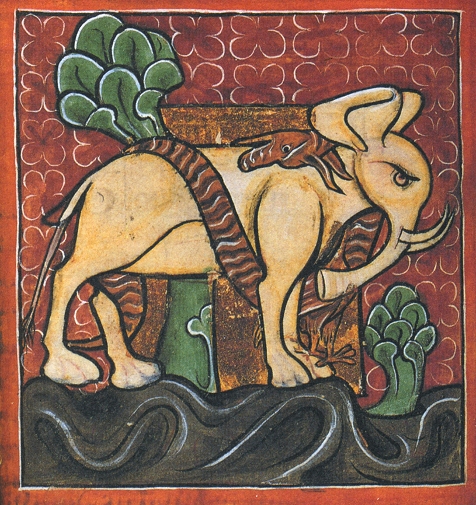- Easg Saint or Holy Fish
- These fish only inhabited wells near churches. There were usually two to a well and they were regarded as sacred. They lived off of hazel nuts which fell from the tree above the well. These nuts gave the fish magical properties, including the ability to speak. To kill the fish would invite divine retribution.
- Fachan
- An evil and vicious Irish spirit, the bane of travelers. It had one hand protruding from its chest, one leg from its abdomen, and one eye in its forehead like the Cyclops. Its whole body was covered with feathers, which appeared ruffled. On the crown of its head a tuft of feathers stood up like a cock's comb. This demon pursued travelers, and leapt on them from behind, killing and mutilating them.
- Falin
- A Scottish mountain demon, haunting Glen Aven. He had a head twice as large as his body, and inhabited the highest crags of the mountains. This was a dangerous spirit, having no natural form, and appearing very occasionally. He was only seen about the break of day, and any creature who crossed the track along which he had been before the sun had shone on it to dispel his evil, was doomed to certain death.
- Fetch
- In English folklore of the fifteenth and sixteenth centuries, an evil demon who roamed about by day and night. Only evil during darkness, anyone who saw it by night was certain to die. Later, in the eighteenth century, the word came to an apparition of a living creature.
- Fin People
- Half fish and half human, the Fin People bask on the shore during the summer near Eynhallow village in the Orkney Islands of Scotland. Once the folk of Eynhallow, the old stories told, were in communion with the Fin People of Finfolkaheen, a twin community beneath the waves. Both Fin-Men and Fin-Women would endeavor to woo human lovers. If they were successful in seducing a human the Fin People lost their fish characteristics so that they could live on land.
- Formorians
- Hideously misshapen monsters of Celtic myth. Balor, the chief of them, had one good eye and one evil eye. It took four strong men to force open the lid of his good eye.
- Fuath
- A water spirit, found in Scotland and of evil nature. It had webbed feet, yellow hair, a tail, no nose, and was dressed in green. The name fuath has become a general term to describe any kind of nature spirit, but usually of the evil kind.
- Gabriel Hounds or Gabble Retchets
- A spirit hound which hunted high in the air. It could be heard yelping overhead during violent storms. To hear these yelps was a presage of death. In the North of England it was thought that they might be the souls of unbaptized children. They were said to be great black hounds with eyes, often as big as saucers, that glowed in the dark. The Black Dog haunted many parts of the country: in Lancashire called 'Trash' or 'Skriker', and on the Isle of Man, where he haunted Peel Castle, known as the Mauthe Doog. In Norfolk he is called Shuck, Old Shuck or the Shuck Dog, and in Suffolk, Shock, his name perhaps coming from Old English scucca, a demon. The Black Dog was in some places thought to be the ghost of the unquiet dead. Black Dogs commonly haunted lanes, footpaths, bridges, crossroads and gateways. See also Devil's Dandy Dogs.
- Ganconer or Gacanagh
- One of the 'little people,' the ganconer's habit was to intrigue and entice young girls by talking to them. They fell so hopelessly in love with him that when he deserted them they pined away and died for love of him. The Irish version had a city of their own in the depths of a lake, from which they emerged periodically to steal cattle.
- Giants
- Read more about giants in myth and legend
- Gigelorum or Giol-Daoram
- The smallest of all creatures, it nested in a mite's ear and could never be seen by the naked eye. Found in Scotland.
- Glas Gaibleanir
- Literally translated, this means the grey white-loined cow. Found in Scotland, she often stayed with poor families to assist them until a fool struck her, or she was milked into a leaky bucket (see Dun Cow of Warwick) when she would depart. Where she slept there was always abundant grass. A saying has evolved around this: 'The grey cow slept there', meaning that the particular piece of land referred to is a very fertile field.
- Glaistig
- A Scottish highland spirit, half-woman, half-goat in form, and clothed in green. This creature had a bit of all the fairy attributes in her, but was particularly kind to old people and the feeble-minded. She worked in the house and did many useful things, but did have her mischievous side which came out in a habit of misdirecting travelers. Like a Kelpie (see Water Horse), she was also partly a water spirit and could be caught and set to work. In Lochaber, Invernesshire, Scotland a blacksmith captured a glaistig and once under lock and key, he knew the creature would have to offer a gift to be released. The blacksmith asked for a herd of fine cattle.
- Grant
- An English demon in the form of a colt which walked on its hind-legs and had fiery eyes first mentioned by Gervase of Tilbury circa 1212 'like foals of a year old'. It was a town spirit and either at midday or just after sunset it would run down the middle of the street. All the dogs barked furiously, and this was said to be a warning of imminent danger.
- Grendel
- Grendel and his mother were believed to be descended from Cain and were regarded as foes of God in the Anglo-Saxon poem Beowulf, which tells of the building of Heorot by the Danish King Hrothgar, and the attacks by Grendel, 'this gruesome prowler of the border land, ranger of the moors, the fen and the fastness,' on his men. He always entered the hall at night, and swiftly wrought havoc there:
'At once the hellish monster, grim and greedy, brutally cruel, started forward and seized thirty thanes even as they slept.'
Beowulf, hearing of these attacks, offered his assistance and lay in wait for Grendel. The monster was captured as he returned to his prey and:'Then time and again Beowulf's band brandished their ancestral swords'
until . . .'fatally wounded, Grendel was obliged to make for the marshes leaving his arm in Beowulf's grasp.'
Later, when searching out his mother, Beowulf found Grendel on his deathbed and cut off his head; it took four thanes to carry the trophy back.
- Grey Man of Macdhui
- The mountain peak of Ben Macdhui, in the Cairngorms, is the setting for one of the most long-lived Scottish monster tales, where the presence of a beast which stands ten feet tall has been reported by climbers. Reports about the monster began in Victorian times and one such came from Professor Norman Collie (1859-1942), of the department of Organic Chemistry in the University of London. A no-nonsense scientist and a avid mountaineer, Collie said that while he was walking on Ben Macdhui in 1891 he became aware of the sound of feet following him, but the steps seemed two or three times the span of a normal gait. He stopped, listened and peered into the mist but saw nothing. Such footfalls have been attested to by many, along with a feeling of sinister presence. An actual figure of enormous size was seen by mountaineer A.M. Kellas in the years after World War I. Others, including Honorary Sheriff substitute George Duncan in 1914, have recorded the figure as wearing a robe and a 'lum hat' – a top hat.
- Gwragedd Annwn
- Lake maidens found in Wales. They are very beautiful, but not as dangerous as mermaids. They frequently marry mortals and live happily.
Photo credits: (Related Resources) (1) Harley MS 3244, British Library Digitised Manuscripts, PD-Art, Wikimedia Commons, (2) MS Body 764, Bodleian Library, Oxford, England, PD-Art, Wikimedia Commons

